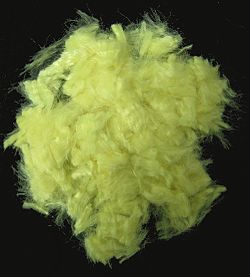
Back كيفلار Arabic Kevlar Azerbaijani کولار AZB Кевлар Bulgarian Kevlar BS Kevlar Catalan Kevlar Czech Kevlar Danish Kevlar German Κέβλαρ Greek
 | |
 | |
| Names | |
|---|---|
| IUPAC name
Poly(azanediyl-1,4-phenyleneazanediylterephthaloyl)[1]
| |
| Identifiers | |
| ChemSpider |
|
| Properties | |
| [-CO-C6H4-CO-NH-C6H4-NH-]n | |
Except where otherwise noted, data are given for materials in their standard state (at 25 °C [77 °F], 100 kPa).
| |
Kevlar (para-aramid)[2] is a strong, heat-resistant synthetic fiber, related to other aramids such as Nomex and Technora. Developed by Stephanie Kwolek at DuPont in 1965,[3][2][4] the high-strength material was first used commercially in the early 1970s as a replacement for steel in racing tires. It is typically spun into ropes or fabric sheets that can be used as such, or as an ingredient in composite material components.
Kevlar has many applications, ranging from bicycle tires and racing sails to bulletproof vests, due to its high tensile strength-to-weight ratio; by this measure it is five times stronger than steel.[2] It is also used to make modern marching drumheads that withstand high impact, and for mooring lines and other underwater applications.
A similar fiber, Twaron, with the same chemical structure was developed by Akzo in the 1970s. Commercial production started in 1986, and Twaron is manufactured by Teijin Aramid.[5][6]
- ^ Mormann, Werner; Hellwich, Karl-Heinz; Chen, Jiazhong; Wilks, Edward S. (2017). "Preferred names of constitutional units for use in structure-based names of polymers (IUPAC Recommendations 2016)". Pure and Applied Chemistry. 89 (11): 1695–1736 [1732]. doi:10.1515/pac-2016-0502. S2CID 104022755.
- ^ a b c "What is Kevlar". DuPont. Archived from the original on 2007-03-20. Retrieved 2007-03-28.
- ^ Mera, Hiroshi; Takata, Tadahiko (2000). "High-Performance Fibers". Ullmann's Encyclopedia of Industrial Chemistry. doi:10.1002/14356007.a13_001. ISBN 978-3527306732.
- ^ "Wholly aromatic carbocyclic polycarbonamide fiber having orientation... - US 3819587 A - IP.com". ip.com.
- ^ Tatsuya Hongū, Glyn O. Phillips, New Fibers, Ellis Horwood, 1990, p. 22
- ^ J. K. Fink, Handbook of Engineering and Specialty Thermoplastics: Polyolefins and Styrenics, Scrivener Publishing, 2010, p. 35
© MMXXIII Rich X Search. We shall prevail. All rights reserved. Rich X Search